Home Gourmet for Everyone
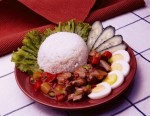 The three daily meals enjoyed by Chinese families are what we call “common home gourmet.” Most ingredients found in home-cooked meals are taken from ordinary grocery and spice list. And the only principle that it abides by is good flavor. The so-called “common home style” also means that it is flexible and ever-changing, full of varieties and does not stick to just one form of cooking. The Chinese, who pay great attention to food, will not settle for bland and identical taste everyday. Under the tenet of a simple and non-luxurious life, cooking homemade dishes is certainly no easy task, as the food not only must entertain the taste buds of the family members, but must also be constantly changing in variety and combination. In general, home meals do not differentiate between “regional styles.” However, due to the fact that China has a vast expanse of territories, with products and living habits different in each area, it objectively creates for the situation where home-style cooking tastes different in each and every home.
The three daily meals enjoyed by Chinese families are what we call “common home gourmet.” Most ingredients found in home-cooked meals are taken from ordinary grocery and spice list. And the only principle that it abides by is good flavor. The so-called “common home style” also means that it is flexible and ever-changing, full of varieties and does not stick to just one form of cooking. The Chinese, who pay great attention to food, will not settle for bland and identical taste everyday. Under the tenet of a simple and non-luxurious life, cooking homemade dishes is certainly no easy task, as the food not only must entertain the taste buds of the family members, but must also be constantly changing in variety and combination. In general, home meals do not differentiate between “regional styles.” However, due to the fact that China has a vast expanse of territories, with products and living habits different in each area, it objectively creates for the situation where home-style cooking tastes different in each and every home.
It is common belief that dinner is the one meal that the Chinese take most seriously, whereas breakfast is the simplest. At a breakfast table of the Chinese, the most common food is the stuffed or plain steamed buns with a bowl of porridge (congee) and a dish of pickled veggies; we could also see wonton, hot soup noodle, rice and stir-fried dishes. Though the “deep-fried twisted dough stick” and soybean milk are standard breakfast items, few families make them at homes, as they are usually purchased from breakfast shops. Milk, oatmeal, or egg and ham sandwiches are no longer rare and fancy in the eyes of the urban population. Eggs and bean curd are the general source of protein in breakfast and are easy to prepare. For lunch and dinner, aside from rice and pasta, there are also stir-fries, soups and porridge for complement. The preparation of homemade foods is usually the responsibility of the female heads of households. But in families with double income, where both the man and woman earn a living, it is not uncommon for a man to make the meal.
Different from the West, the majority Han Chinese and most Chinese minority nationalities have little dairy beverage each day. But for the northwestern minority nationalities, dairy products are an important component of daily diet.
In areas where pasta and pastry are the principal food components, 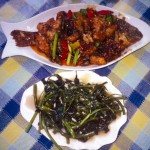 homemakers can usually use wheat flour, corn flour, sorghum flour, soy flour, buckwheat flour or naked oatmeal flour to make a wide variety delicious treats. According to different taste preferences, pasta dishes can be stir-fried, fried, stewed, steamed, braised, simmered and so on. When having a bowl of pasta, jiaotou, or pasta sauce, is a top priority, and usually comes in the form of fried bean sauce (usu. with minced meat), soy gravy, dipping, soup stock and so on. Second priority to eating pasta is the shredded vegetables mixings, the types of vegetables vary during the seasons. At the birthplace of Chinese pasta, Shanxi Province, there are at least 280 types of pasta in the cookbooks.
homemakers can usually use wheat flour, corn flour, sorghum flour, soy flour, buckwheat flour or naked oatmeal flour to make a wide variety delicious treats. According to different taste preferences, pasta dishes can be stir-fried, fried, stewed, steamed, braised, simmered and so on. When having a bowl of pasta, jiaotou, or pasta sauce, is a top priority, and usually comes in the form of fried bean sauce (usu. with minced meat), soy gravy, dipping, soup stock and so on. Second priority to eating pasta is the shredded vegetables mixings, the types of vegetables vary during the seasons. At the birthplace of Chinese pasta, Shanxi Province, there are at least 280 types of pasta in the cookbooks.
For homes with rice as principal food, nothing is more common than a pot full of steamy, savory rice. But day after day, this becomes rather monotonous. So people spent much time in coming up with different ways of cooking and combinations. Steam, boil, stir-fry, roast, deep-fry and simmer, different ways of cooking bring out drastically different texture and taste in rice. In daily life, the Chinese usually would not and need not have excessive meat dishes. More often, inexpensive vegetables with good value are preferred. Turnips or radishes, green vegetables and bean curd are almost indispensable from each Chinese household. Green turnip, white turnip, radish and carrot are available throughout the country all year round. These veggies can be eaten raw, boiled, stir-fried, pickled and so on. “Green vegetables” include Chinese cabbage, spinach, rape, celery, Chinese chive (leek), mustard and more, where we eat their leaves and stems. Common ways of cooking green vegetables is none other than cold dish with dressing, cooked or stir-fried, and boiled or stewed. If one dislikes certain vegetables for they do not facilitate the eating of rice very well, small amounts of meat or eggs can be mixed in for stir-frying. For bean curd, the most common and simplest way to prepare is to serve cold with sauce or boil with water then dress in soy sauce, sesame oil sauce or other sauces. Tofu that is deep-fried and then baked with sauce or stewed with vegetables is also very common. In all the Chinese restaurants around the world, Mapo Tofu, meaning numb-hot bean curd, can be found. It is prepared simply by placing diced bean curd into pre-cooked minced meat, and after fully boiled, add some hot sauce and Chinese prickly ash powder, and there you have a fully prepared dish. Aside from tofu, other kinds of food made from beans, which belong to the same family as bean curd, are also common dishes during all seasons of the year.
The Chinese usually classify meat dishes into four categories, which are “chicken, duck, fish and meat.” But with developments in modern breeding industries, pork has replaced chicken, and became the most common meat for most Chinese nationalities, with Han Chinese especially. In the past, it was because pork is hard to come by, now because it can be enjoyed very often; ways of cooking for pork are the most numerous among all the meats. These include stir-fried, simmered, white-cut with sauce, twice-cooked, steamed with sauce and turned upside-down, steamed with ground rice, boiled in hot oil and so on. Most families can make these dishes. For home cooked pork, many people like to use starch, so pork stir-fry feels even more tender.
The Chinese have quite a long history of breeding chicken. Since ancient times, the Chinese have considered Chicken to be of great taste and regard chicken soup as a great tonic drink. Chicken can be steamed or stewed in clear soup, simmered with soy sauce, white-cut with dipping, or stewed in yellow wine, with no less than a dozen ways of preparation. Just the recipes for chicken can be compiled into thick books. Compared with chicken, ducks have a much higher price tag in northern China. Common northern families ” href=”http://www.chinascan.org/archives/711/fish”>![]() seldom cook duck though, as the famed Beijing (Peking) Roast Duck has to be enjoyed in special restaurants. The place most skilled in making duck dishes is the Jiangsu-Zhejiang area. There, Salty Watered Duck and Laobao Duck are not just treats of recognition of restaurants; many homemakers can make the dishes well too. There are many ways to cook fish as well. Most times, fresh fish is steamed or simmered in clear soup. Fish a little lesser in freshness would be braised, or one can add sugar and vinegar for Sweet and Sour fish. Beef and mutton are the principal foods of western Chinese minority nationalities. Most common are barbecue beef or lamb. But in most Han Chinese homes, aside from quick-fried, stewed in soy sauce, or simmered, the most popular way of preparing beef and lamb is none other than “rinsing” in a boiling hotpot.
seldom cook duck though, as the famed Beijing (Peking) Roast Duck has to be enjoyed in special restaurants. The place most skilled in making duck dishes is the Jiangsu-Zhejiang area. There, Salty Watered Duck and Laobao Duck are not just treats of recognition of restaurants; many homemakers can make the dishes well too. There are many ways to cook fish as well. Most times, fresh fish is steamed or simmered in clear soup. Fish a little lesser in freshness would be braised, or one can add sugar and vinegar for Sweet and Sour fish. Beef and mutton are the principal foods of western Chinese minority nationalities. Most common are barbecue beef or lamb. But in most Han Chinese homes, aside from quick-fried, stewed in soy sauce, or simmered, the most popular way of preparing beef and lamb is none other than “rinsing” in a boiling hotpot.
All regions have dried or pickled vegetables, beans, eggs or meats. These foods intended for prolonged storage, are becoming less of a real course during meals as living conditions improve, but more of a tasty appetizing treat.
The Spring Festival
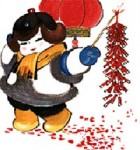 The Spring Festival is the most important festival for the Chinese people and is when all family members get together, just like Christmas in the West. All people living away from home go back, becoming the busiest time for transportation systems of about half a month from the Spring Festival. Airports, railway stations and long-distance bus stations are crowded with home returnees.
The Spring Festival is the most important festival for the Chinese people and is when all family members get together, just like Christmas in the West. All people living away from home go back, becoming the busiest time for transportation systems of about half a month from the Spring Festival. Airports, railway stations and long-distance bus stations are crowded with home returnees.
The Spring Festival falls on the 1st day of the 1st lunar month, often one month later than the Gregorian calendar. It originated in the Shang Dynasty (c. 1600 BC-c. 1100 BC) from the people’s sacrifice to gods and ancestors at the end of an old year and the beginning of a new one.
Strictly speaking, the Spring Festival starts every year in the early days of the 12th lunar month and will last till the mid 1st lunar month of the next year. Of them, the most important days are Spring Festival Eve and the first three days. The Chinese government now stipulates people have seven days off for the Chinese Lunar New Year.
Many customs accompany the Spring Festival. Some are still followed today, but others have weakened.
Store owners are busy then as everybody goes out to purchase necessities for the New Year. Materials not only include edible oil, rice, flour, chicken, duck, fish and meat, but also fruit, candies and kinds of nuts. What’s more, various decorations, new clothes and shoes for the children as well as gifts for the elderly, friends and relatives, are all on the list of purchasing.
Before the New Year comes, the people completely clean the indoors and outdoors of their homes as well as their clothes, bedclothes and all their utensils.
Then people begin decorating their clean rooms featuring an atmosphere of rejoicing and festivity. All the door panels will be pasted with Spring Festival couplets, highlighting Chinese calligraphy with black characters on red paper. The content varies from house owners’ wishes for a bright future to good luck for the New Year. Also, pictures of the god of doors and wealth will be posted on front doors to ward off evil spirits and welcome peace and abundance.
The Chinese character “fu” (meaning blessing or happiness) is a must. The character put on paper can be pasted normally or upside down, for in Chinese the “reversed fu” is homophonic with “fu comes”, both being pronounced as “fudaole.” What’s more, two big red lanterns can be raised on both sides of the front door. Red paper-cuttings can be seen on window glass and brightly colored New Year paintings with auspicious meanings may be put on the wall.
People attach great importance to Spring Festival Eve. At that time, all family members eat dinner together. The meal is more luxurious than usual. Dishes such as chicken, fish and bean curd cannot be excluded, for in Chinese, their pronunciations, respectively “ji”, “yu” and “doufu,” mean auspiciousness, abundance and richness. After the dinner, the whole family will sit together, chatting and watching TV. In recent years, the Spring Festival party broadcast on China Central Television Station (CCTV) is essential entertainment for the Chinese both at home and abroad. According to custom, each family will stay up to see the New Year in.
Waking up on New Year, everybody dresses up. First they extend greetings to their parents. Then each child will get money as a New Year gift, wrapped up in red paper. People in northern China will eat jiaozi, or dumplings, for breakfast, as they think “jiaozi” in sound means “bidding farewell to the old and ushering in the new”. Also, the shape of the dumpling is like gold ingot from ancient China. So people eat them and wish for money and treasure.
Southern Chinese eat niangao (New Year cake made of glutinous rice flour) on this occasion, because as a homophone, niangao means “higher and higher, one year after another.” The first five days after the Spring Festival are a good time for relatives, friends, and classmates as well as colleagues to exchange greetings, gifts and chat leisurely.
Burning fireworks was once the most typical custom on the Spring Festival. People thought the spluttering sound could help drive away evil spirits. However, such an activity was completely or partially forbidden in big cities once the government took security, noise and pollution factors into consideration. As a replacement, some buy tapes with firecracker sounds to listen to, some break little balloons to get the sound too, while others buy firecracker handicrafts to hang in the living room.
The lively atmosphere not only fills every household, but permeates to streets and lanes. A series of activities such as lion dancing, dragon lantern 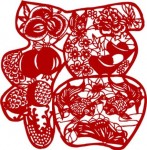 dancing, lantern festivals and temple fairs will be held for days. The Spring Festival then comes to an end when the Lantern Festival is finished.
dancing, lantern festivals and temple fairs will be held for days. The Spring Festival then comes to an end when the Lantern Festival is finished.
China has 56 ethnic groups. Minorities celebrate their Spring Festival almost the same day as the Han people, and they have different customs.
Mid-Autumn Festival
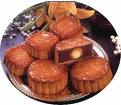 Time: Always On the 15th Day of the 8th Month by the Chinese Lunar Calendar
Time: Always On the 15th Day of the 8th Month by the Chinese Lunar Calendar
Venue: All over China
Origin: During the Zhou Dynasty (16th-11th centuries BC), the night of the full moon was an occasion for the Chinese to hold rituals to greet the cool weather and sacrifice to the Goddess of the Moon. By the Tang Dynasty (618-907) moon-watching and merry-making had become part of the ritual. During the Northern Song (960-1127), the 15th day of the 8th lunar month was designated as Mid-Autumn Festival. When night falls, the orb of the moon hangs full in the firmament, shedding a flood of silvery light over the land, while family members in China gather for the happiness of reunion, munching moon cakes and marveling at the chastened glory of the 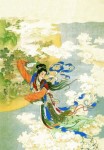 Goddess of the Moon. By Chinese custom the 15th day of the 8th lunar month is a day for family reunion as symbolized by the full moon and the moon cake.
Goddess of the Moon. By Chinese custom the 15th day of the 8th lunar month is a day for family reunion as symbolized by the full moon and the moon cake.
What’s On: Ceremonies to make libation and sacrifices to the moon, and watching the moon while enjoying moon cakes. There is always something dream-like and romantic about Mid-Autumn Festival, on account of its close association with such Chinese fables as Chang’e fleeing to the moon, the man Wu Gang performing the unending servitude to cutting an osmanthus tree, and the Jade Rabbit pounding medicinal herbs with a pestle. For men of letters the festival is an occasion to get together, improvise poems over a cup of wine and recite them to each other.
Copyright Law of the People’s Republic of China
 National People’s Congress on 7 September 1990, and revised in accordance with the Decision on the Amendment of the Copyright Law of the People’s Republic of China adopted at the 24th Session of the Standing Committee of the Ninth National People’s Congress on 27 October 2001.)
National People’s Congress on 7 September 1990, and revised in accordance with the Decision on the Amendment of the Copyright Law of the People’s Republic of China adopted at the 24th Session of the Standing Committee of the Ninth National People’s Congress on 27 October 2001.)
Chapter I General Provisions
Article 1 This Law is enacted, in accordance with the Constitution, for the purposes of protecting the copyright of authors in their literary, artistic and scientific works and the copyright-related rights and interests, of encouraging the creation and dissemination of works which would contribute to the construction of socialist spiritual and material civilization, and of promoting the development and prosperity of the socialist culture and science.
Article 2 Works of Chinese citizens, legal entities or other organizations, whether published or not, shall enjoy copyright in accordance with this Law.
Any work of a foreigner or stateless person which is eligible to enjoy copyright under an agreement concluded between the country to which the foreigner belongs or in which he has habitual residence and China, or under an internationa1 treaty to which both countries are party, shall be protected in accordance with this Law.
Works of foreigners or stateless persons first published in the territory of the People’s Republic of China shall enjoy copyright in accordance with this Law.
Any work of a foreigner who belongs to a country which has not concluded an agreement with China, or which is not a party to an international treaty with China or a stateless person first published in an country which is a party to an international treaty with China, or in such a member state or nonmember state, shall be protected in accordance with this Law.
Article 3 For the purposes of this Law, the term “works” includes works of literature, art, natural science, social science, engineering technology and the like which are expressed in the following forms:
(1) written works;
(2) oral works;
(3) musical, dramatic, quyi’1, choreographic and acrobatic works;
(4) works of fine art and architecture;
(5) photographic works;
(6) cinematographic works and works created by virtue of an analogous method of film production;
(7) drawings of engineering designs, and product designs; maps, sketches and other graphic works and model works;
(8) computer software;
(9) other works as provided for in laws and administrative regulations.
Article 4 Works the publication or distribution of which is prohibited by law shall not be protected by this Law.
Copyright owners, in exercising their copyright, shall not violate the Constitution or laws or prejudice the public interests.
Read the rest of this entry »